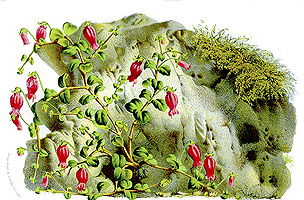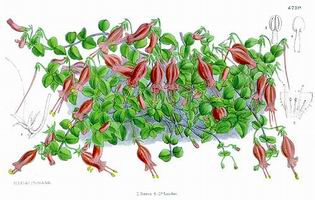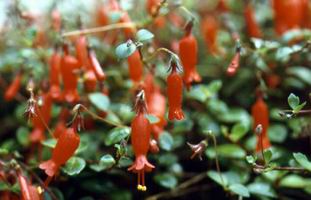

Left: Fl. de Serres, t. 1646
Right: Bot. Mag. t. 6720
Full name and orig. publication: Sarmienta Ruiz & Pav., Prodr. 4 (1794), nom. cons.
Etymology: Named in honor of Martino Sarmiento, a Spanish Benedictine monk, philologist and naturalist of the 18th century.
Synonym: Urceolaria Huth (1758), nom. rejic.
Infrafamilial position: Coronantheroid Gesneriaceae (Gesnerioideae – Coronanthereae).
Description: Suffrutescent creeper or climber, usually epiphytic. Stems slender, flexuous, sparingly branched, rooting at the basal nodes. Leaves small, opposite, subsessile, ovate to suborbicular, rather fleshy, entire or obscurely crenate, glabrous, nerves obscure. Flowers axillary, solitary, pendulous. Sepals free, linear to lanceolate. Corolla scarlet; tube elongate, strongly constricted at the base, inflated in the middle and again narrowed below the limb; limb oblique, subregular, lobes rounded, spreading. Fertile stamens 2, the posterior ones; filaments inserted near corolla base, slender, long exserted; anthers elliptical, free, the sterile anterior stamens with long filaments and clavate tips or minute anthers, included; fifth stamen a short staminode. Disc ring-shaped, adnate to ovary. Ovary superior; style long, slender, exserted; stigma small, simple. Fruit a fleshy berry.
Chromosome number: 2n = ± 74.
Type and only species: Sarmienta repens Ruiz & Pav., nom. illeg. (type) = S. scandens (J.D. Brandis) Pers.
Distribution: S Chile and Chiloe Island.
Ecology: Occurring in cool rain forest, growing on damp or mossy rocks and tree trunks.
Notes: The red flowers suggest pollination by birds.
Selected references: Wiehler, Selbyana 6: 160 (1983); Zollner, Palmengarten 55: 25-27 (1991), illustr.
Bibliography: See Skog, L.E. & J.K. Boggan. 2005. Bibliography of the Gesneriaceae. 2nd edition: http://persoon.si.edu/Gesneriaceae/Bibliography.
Illustrations:
 |
 |
Sarmienta scandens (J.D.Brandis) Pers.
Left: Fl. de Serres, t. 1646 |
 |
Sarmienta scandens (J.D.Brandis) Pers.
Chile, phot. W. Barthlott |
last modified: 2007-07-13